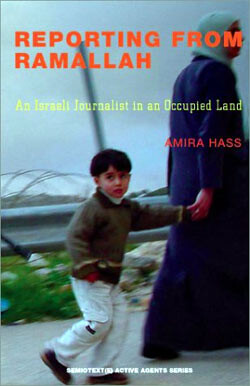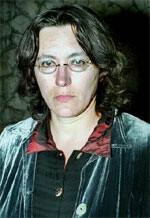The Electronic Intifada 11 December 2003

The cover of Reporting from Ramallah. Click to buy the book on Amazon.com.
Hass is an Israeli journalist and recipient of the UNESCO Guillermo Camo World Press Freedom Prize for 2003. From 1993 to 1997, she reported exclusively from Gaza. Her first book, Drinking the Sea at Gaza: Days and Nights in a Land under Siege (Henry Holt, 2000,) is available in several languages. Between 1997 and 2002, Hass served as Ha’aretz’s chief West Bank and Gaza correspondent and published some 500 articles and op-ed columns for the leading liberal daily.
In the foreword to Reporting from Ramallah, filmmaker and activist Rachel Leah Jones describes Hass’ body of work as the complete story on the confiscation of land, paving of bypass roads, and expansion of Israeli settlements. These 37 selected writings form a shorter chronological account aimed primarily at a target audience of Israeli Jews. The names and places make a challenging read for those unfamiliar with the region, but are essential to understanding the socio-political history of the Intifada.
Hass is the daughter of concentration camp survivors and — atypically for the region’s journalists and otherwise unheard of among Israeli correspondents — lives among the people she reports on. Hass has a thorough understanding of both Israelis and Palestinians. She occasionally appears in her essays as a “woman in the crowd” or an “Israeli journalist” who was present. Events transpire on or near the date of the essays and recreate the immediacy of the original reports. Her tone remains descriptive as she explores Israeli laws and perceptions, and the danger of what Hass terms “bio-religious ideology,” which foully assumes a murderous intent is inherent in all Palestinians.
Early in the book (July 1998), writing about home demolitions in the West Bank, she notes the destruction of 775 homes built in Israeli-controlled Area C and the issuing of another 689 demolition orders during the same reporting period. According to Hass, demolitions are mostly homes built or expanded without the impossible to obtain permits — “illegal” construction as defined by the Israeli “Civil Administration” and Jerusalem’s Israeli municipality. Every home is treated as an individual crime, which obscures the fact that the policy against Palestinian building is systemic.
Hass cites the statistic as evidence the law contradicts basic principles of justice. “When the law is violated with such desperate audacity” one has to question the law itself, because large-scale lawbreaking indicts the lawmakers more than the lawbreakers. She continues the discussion in January 1999, and states thousands of Palestinians are criminals or potential criminals because they must break the law in order to survive. They give false addresses, travel to Jerusalem without the required permit, and continue to live in areas from which they are expelled as they have no other choice.
The book includes alarming descriptions of Palestinian curfews, and the effects of the Israeli occupation on daily life. An especially moving account is a November 2000 interview with an Israeli soldier, in which he delineates firing orders with dehumanizing detail.
“Every day, the regulations for opening fire change, sometimes several times a day,” he says. The regulations vary from place to place. Sharpshooters are given precise criteria. “They” (the Palestinians) can be shot in the leg if they throw Molotov cocktails or in the head if they pull out a weapon. The regulations forbid the shooting of children, but the soldier goes on to describe several situation in which they might be shot by mistake. International law states a child is anyone up to age 18. Israel considers anyone over 12 years of age to be an adult.
Hass further examines Israel’s view of reality when she writes in January 2002 about the ban on Israelis entering Palestinian-controlled Area A. Although, the stated purpose is to protect citizens, the ban also serves to control Israeli perception about the real balance of power in the territories, of them discovering “who is threatened and who is doing the threatening.”

Amira Hass
Historically, the competition for resources and the presence of an occupying army set the conditions for an oppressor to carry out mass destruction, and the identification of a dehumanized bio-religious enemy provides the rational. All the elements for human tragedy are present. In the face of overwhelming frustration and despair, Hass’s book offers a human portrait of the Palestinian people and demands that we understand the socio-historical factors contributing to the Intifada.
Tina Dybvik is a writer based in Minnesota.
Related Links:



